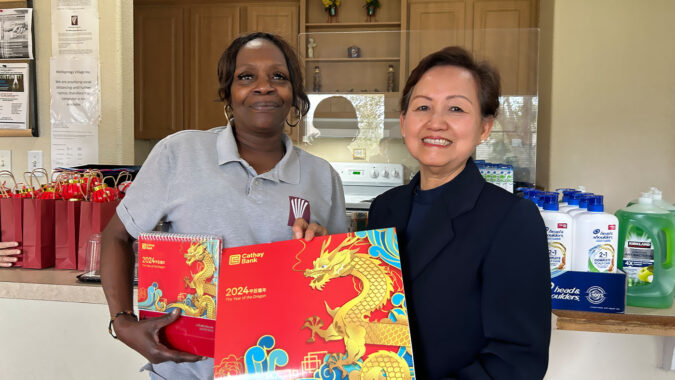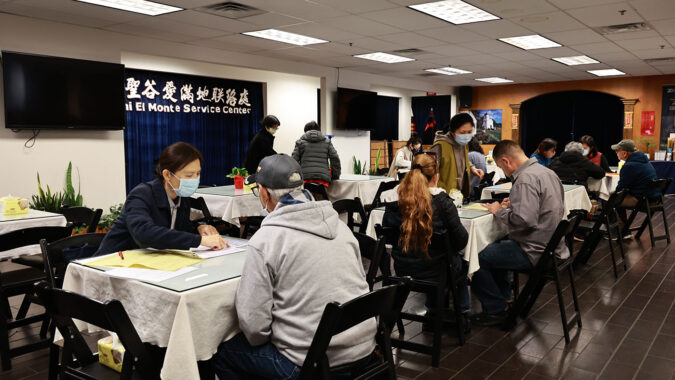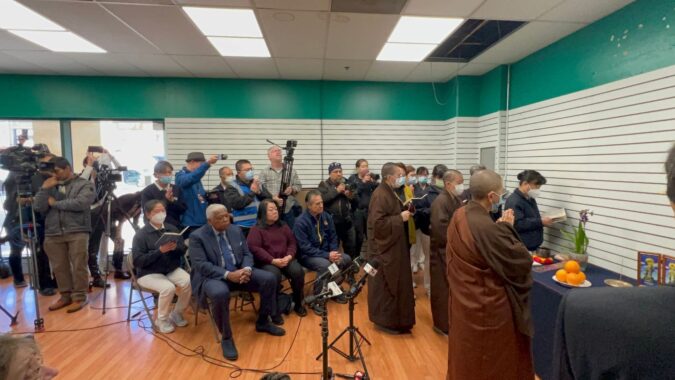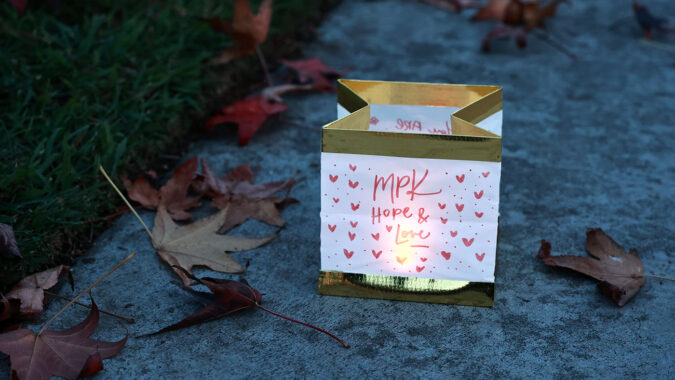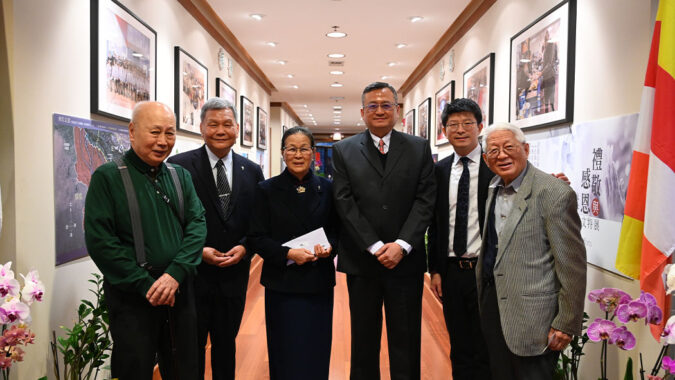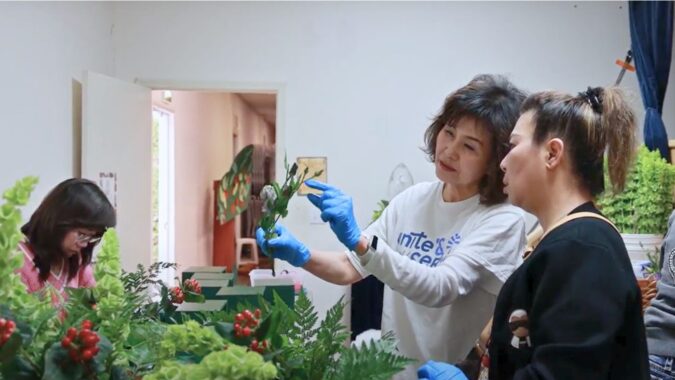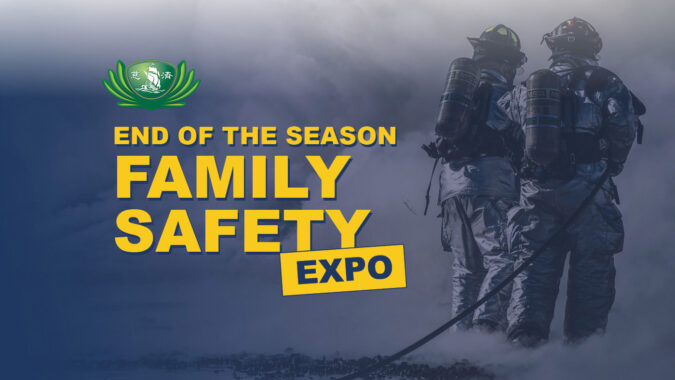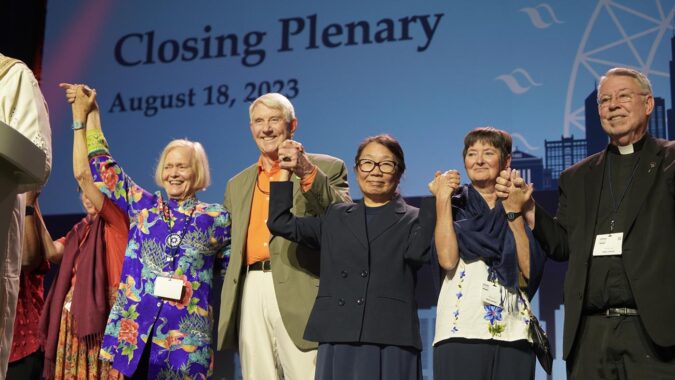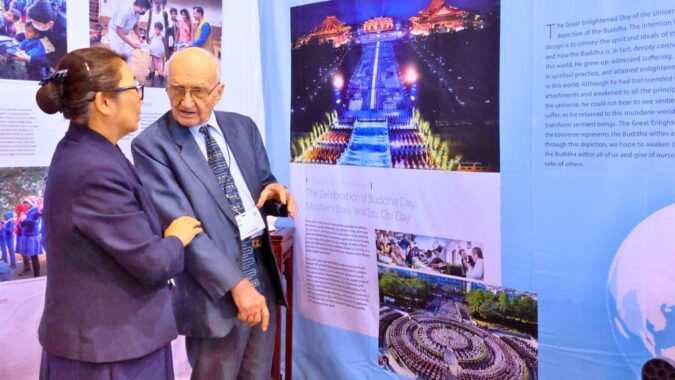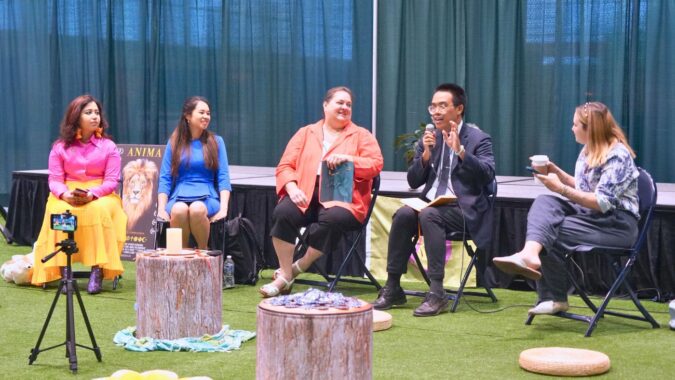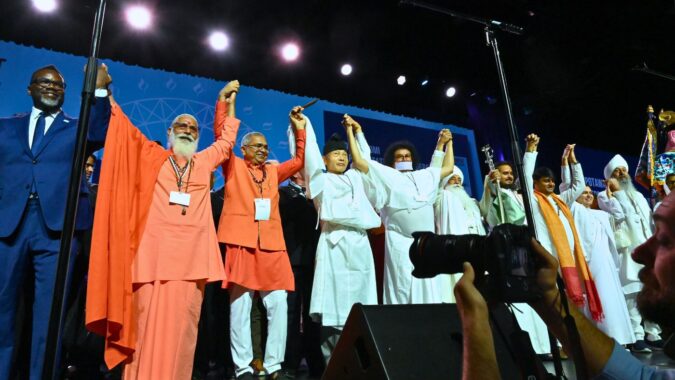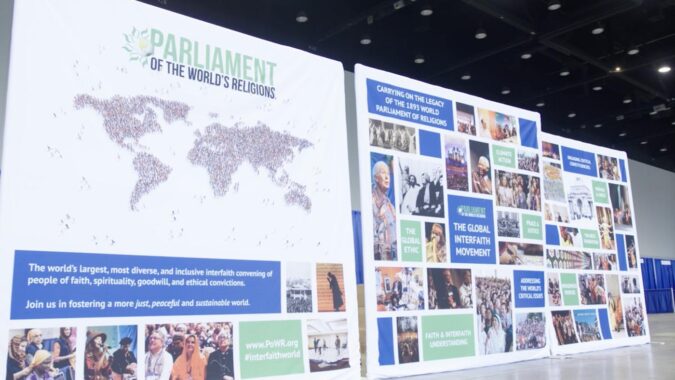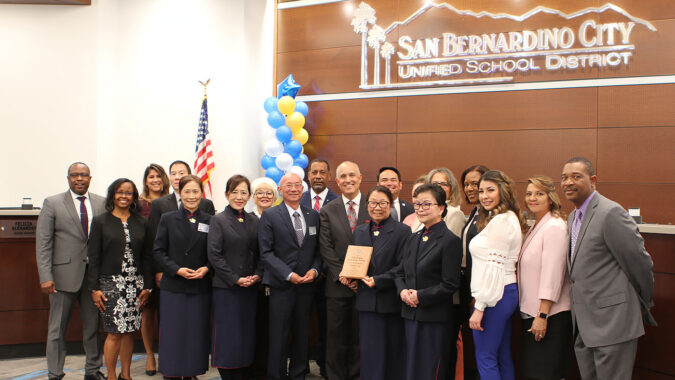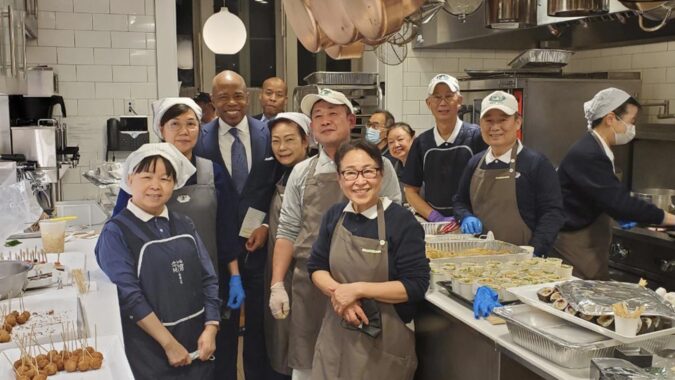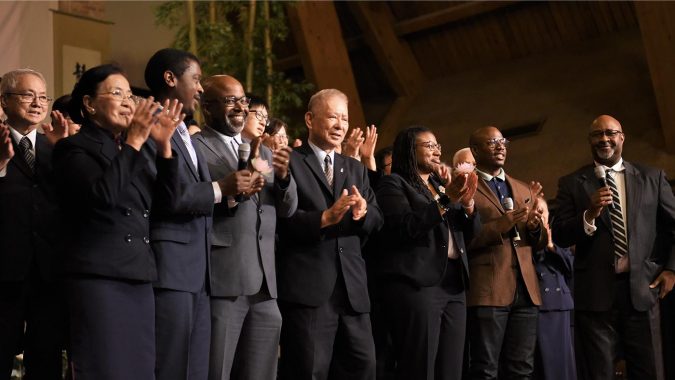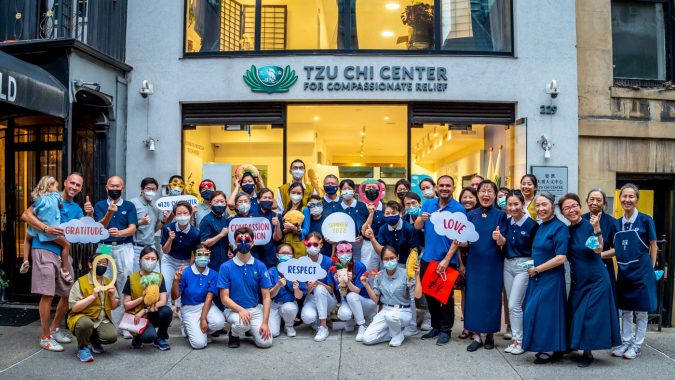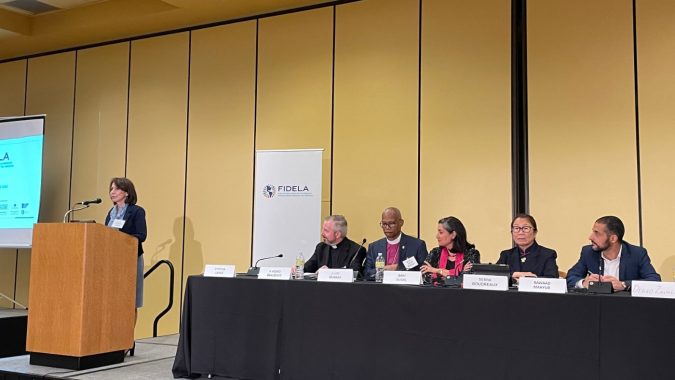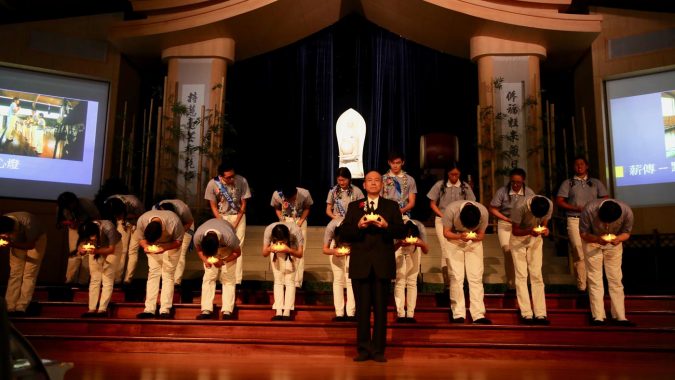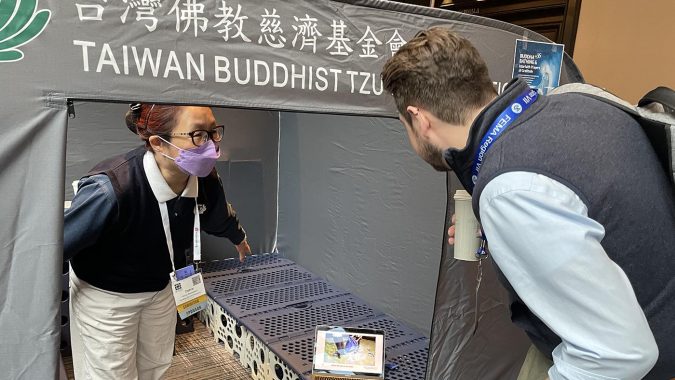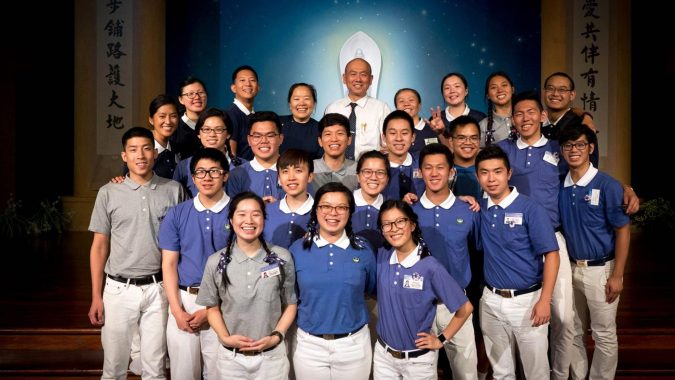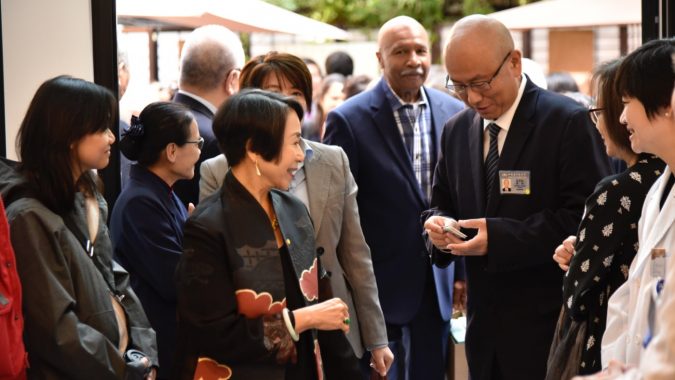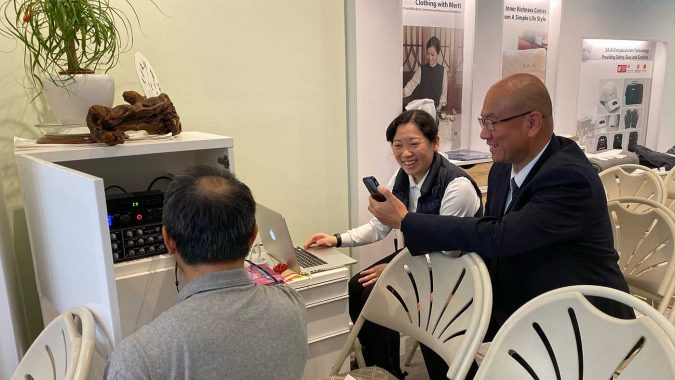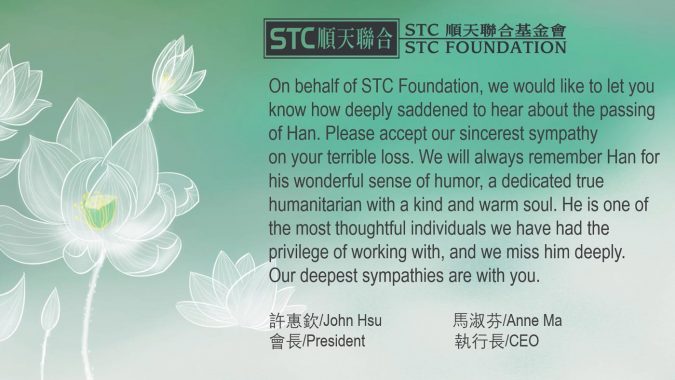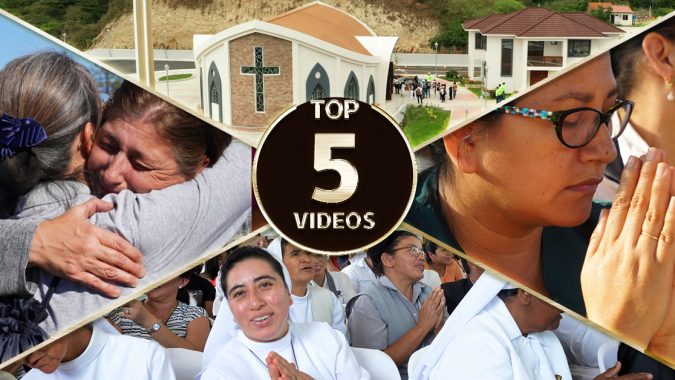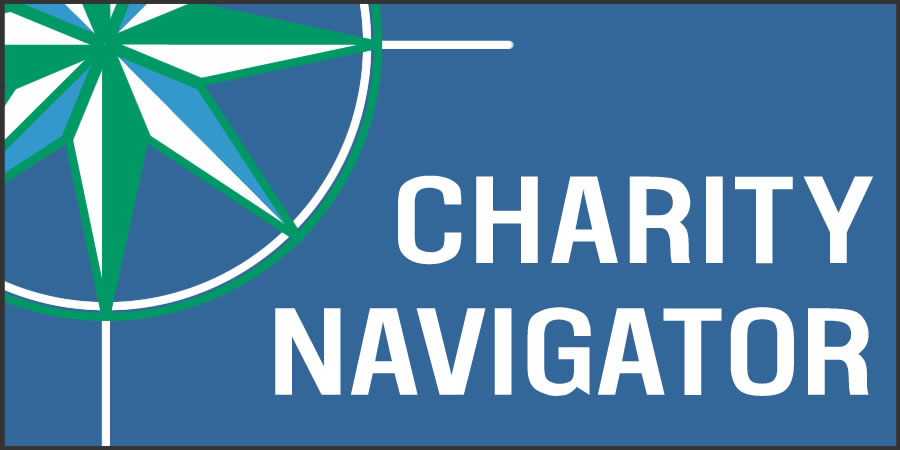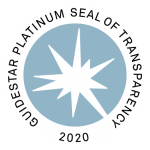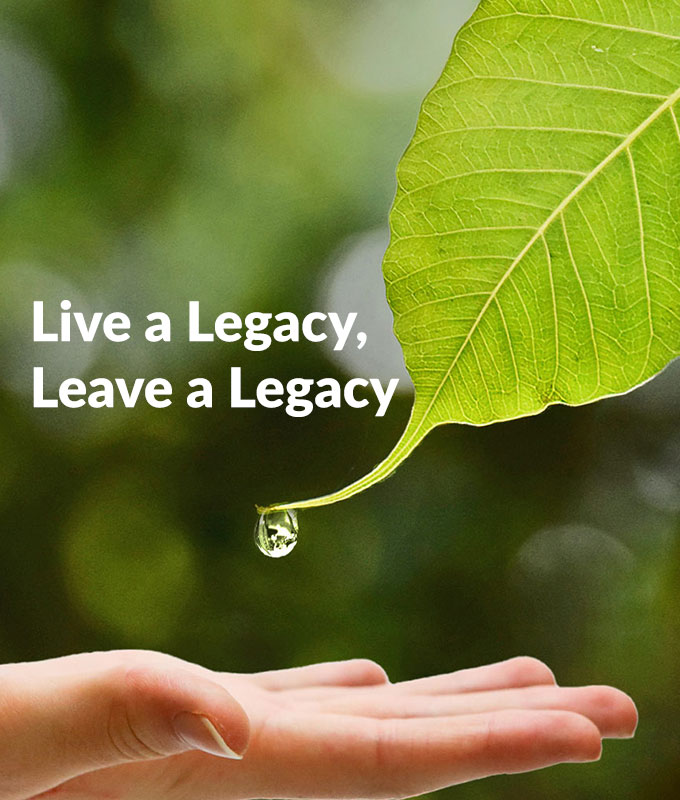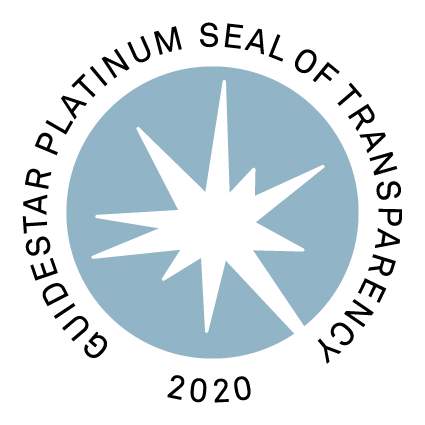
Written by Ida Eva Zielinska
On Day 4 of the Parliament of the World’s Religions (PoWR), the Tzu Chi delegation participated in four parallel sessions. Tzu Chi volunteers also held the second round of Tzu Chi’s Sustainability Fashion Show, the first taking place the previous day.
The first session, “From Sharm-el-Sheikh to Dubai: Food Systems at the UN,” moderated by Steve Chiu, Buddhist Tzu Chi Foundation’s Representative to the UN, brought together Emily Echevarria, Director of Climate Action at the PoWR; Dr. Marium Husain, President of the Islamic Medical Society of North America and a member of the Faith for Food Coalition; Kehkashan Basu, Founder-President of the global social innovation enterprise Green Hope Foundation; and Saphira Rameshefar, the Baha’i International Community’s UN Representative. The panel focused on the role of global food systems in the 2022 UN Climate Change Conference in Egypt (COP27) discussions, the outcomes of those discussions, and how food will play a role at the upcoming 2023 UN Climate Change Conference in the UAE (COP28).
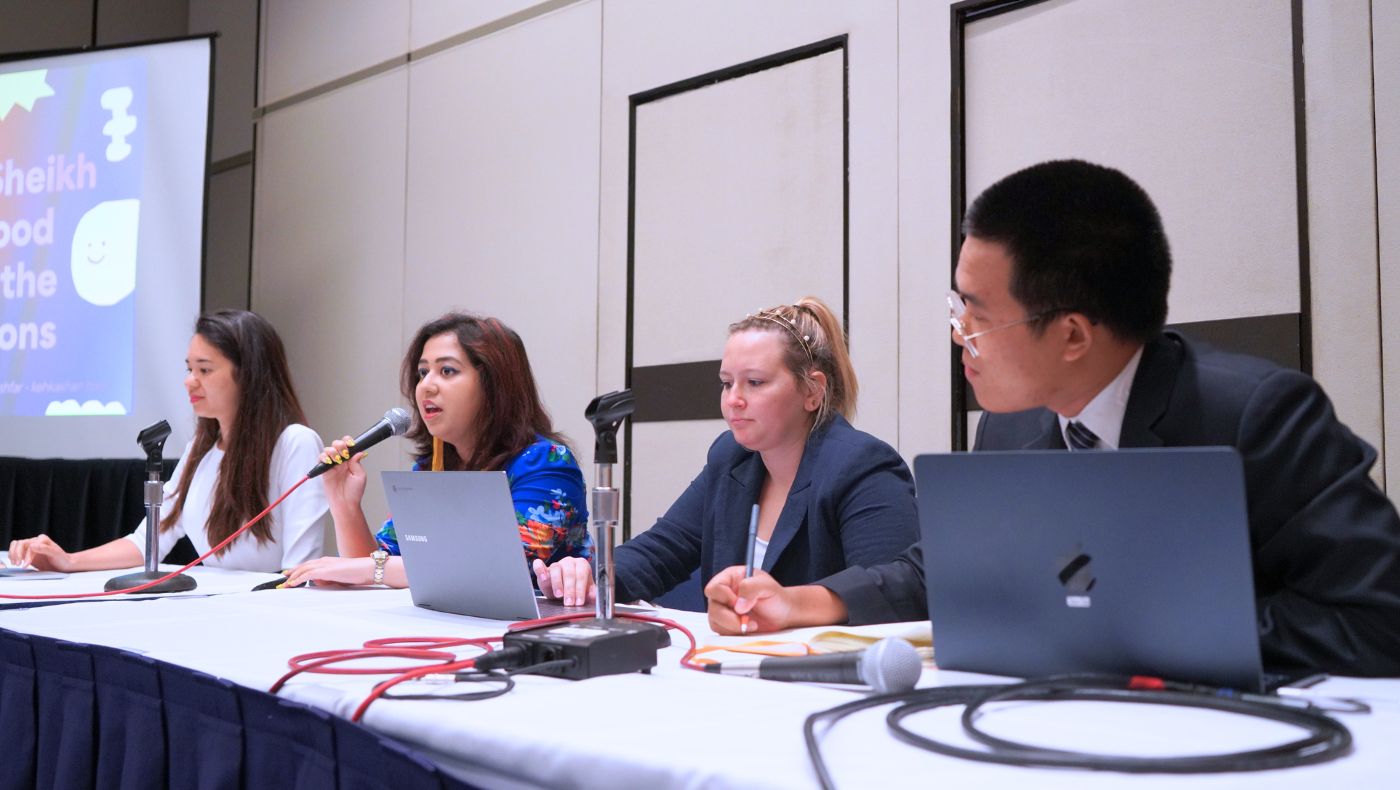
Tzu Chi’s Sustainability Fashion Show
Next on the program, Tzu Chi held its second Sustainability Fashion Show with Annie Chow acting as MC, as Tzu Chi volunteers and Tzu Chi University students demonstrating the line of uniforms, clothing, and other products produced from recycled Polyethylene terephthalate (PET) plastic bottles.
We had to come up with a program to not only introduce our DA.AI technology, or our compassionate technology, but also to make sure that we engage people who come to this green tent program so they understand the reason behind eco-design. Ultimately, we’re hoping that we can influence people to change their lifestyle to be more climate-friendly.
Sue Huey Shann
Local Chicago Logistics Coordinator
The show began with a showcase of Tzu Chi uniforms, beginning with the “blue sky, white clouds” uniform, namely, blue shirts and white pants, worn by certified Tzu Chi volunteers.
Master Cheng Yen designed these uniforms to represent the practice of mindfulness, that when we volunteer and in our lives, our minds should be as limitless as the blue sky and as pure as white clouds. Our uniforms are a reminder to act as living examples of the Buddha, known as bodhisattvas. Dharma Master Cheng Yen reminds us that our uniforms are not just a physical piece of clothing we wear; they are to be worn in our hearts as a reminder of Tzu Chi virtues, through which volunteers take an oath to serve sincerely.
Annie Chow
Tzu Chi Volunteer
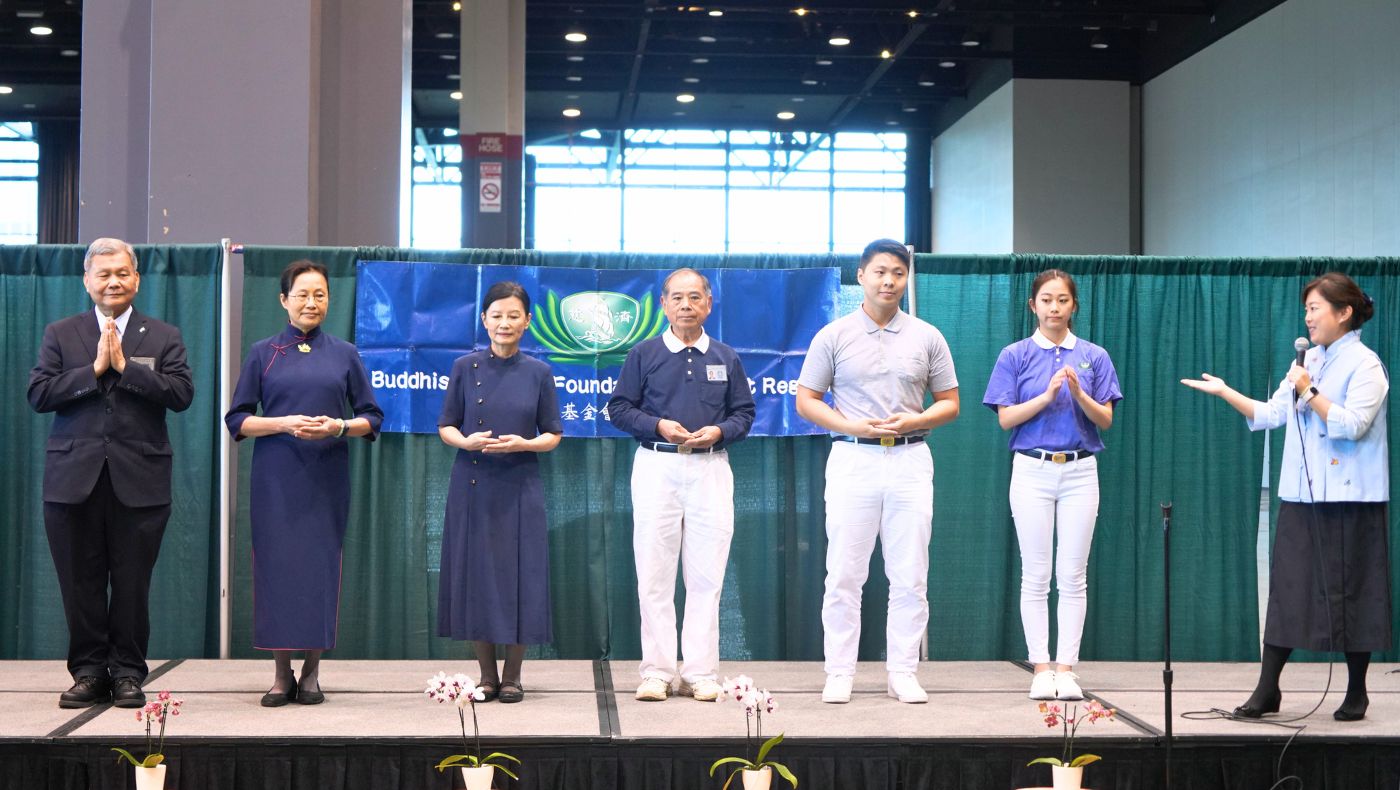
As volunteers marched across the stage wearing Tzu Chi uniforms, Chow explained about the other tops worn by the Tzu Chi family: Sky blue for collegiate volunteers and gray for those in training to be certified volunteers. For spiritual training or practices, female certified volunteers wear an eightfold path dress, and for formal Tzu Chi events, a navy qipao, a traditional Chinese dress with a mandarin collar. Male certified volunteers wear a navy suit with a tie and a clip with the Tzu Chi emblem.
Beyond their surface appearance, the uniforms embody a powerful environmental message as they are all made from recycled PET plastic bottles by DA.AI Technology, Inc. (in Chinese, DA.AI means “Great love”), a company established by disciples of Ven. Master Cheng Yen. Chow recounted how 33 years ago, in 1990, Master Cheng Yen asked volunteers to start doing recycling work to take care of Mother Earth. “Taiwanese people consumed hundreds of thousands of plastic bottles, and there weren’t any sophisticated recycling programs. Plastic bottles in a landfill would take over a thousand years to decompose. Master Cheng Yen wondered if there’s a way to both protect the environment by recycling plastic bottles and help other people.”
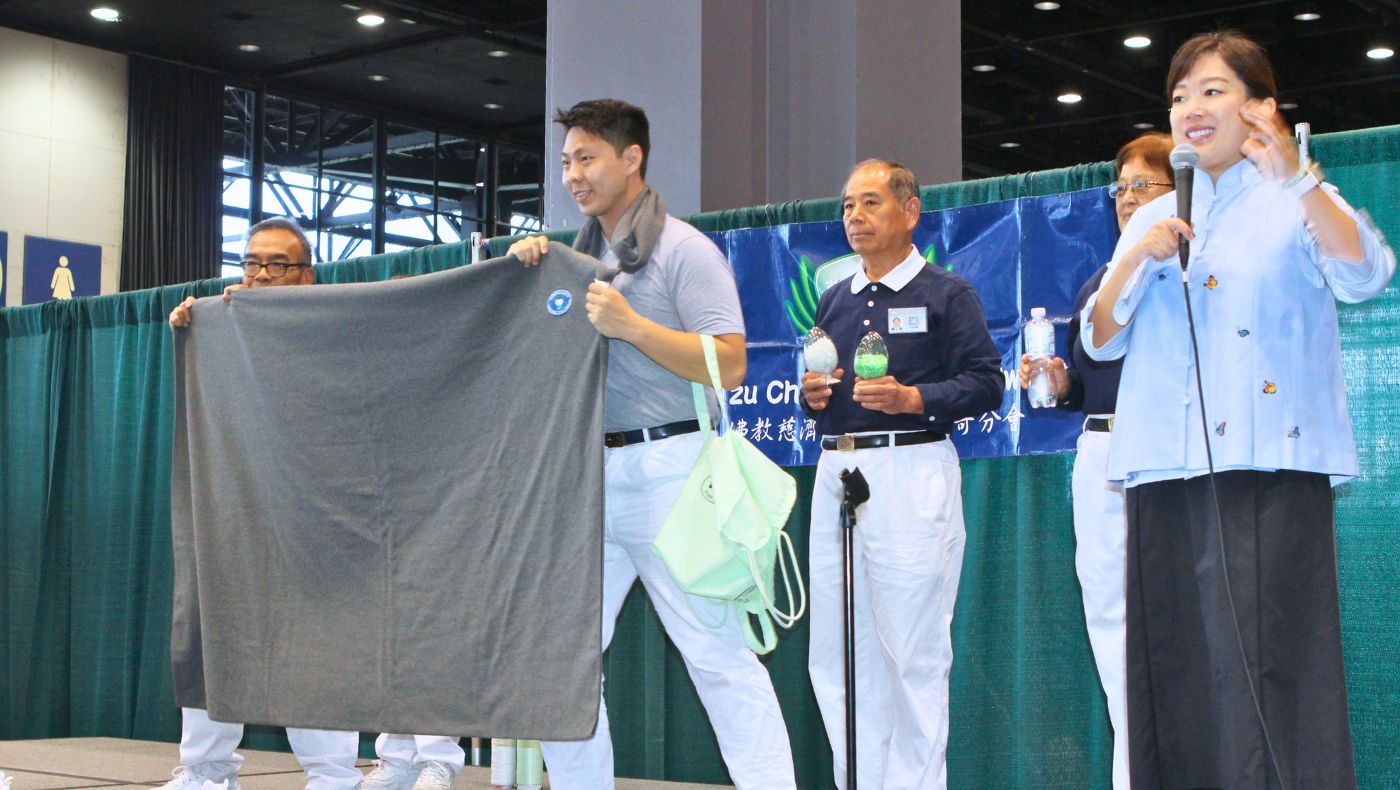
Thanks to the innovative process developed by DA.AI Technology Inc., they could “turn plastic into treasure.” Chow described the lengthy process involved in transforming recycled PET bottles into the yarn used to make a variety of materials and products. Among the most popular products are the signature eco-blanket and eco-scarves that Tzu Chi volunteers give out during disaster relief missions. “From 2003-2020, we distributed 1.2 million DA.AI eco-blankets during disaster relief events in 44 countries,” Chow shared.
Tzu Chi also designed and produced an award-winning multi-purpose folding bed that one can use for sleeping and sitting, which, as the volunteers in the show demonstrated, can be easily folded and transported. The fashion show then highlighted the highly functional nature of eco-friendly products designed for disaster relief settings, which can be dangerous and challenging.
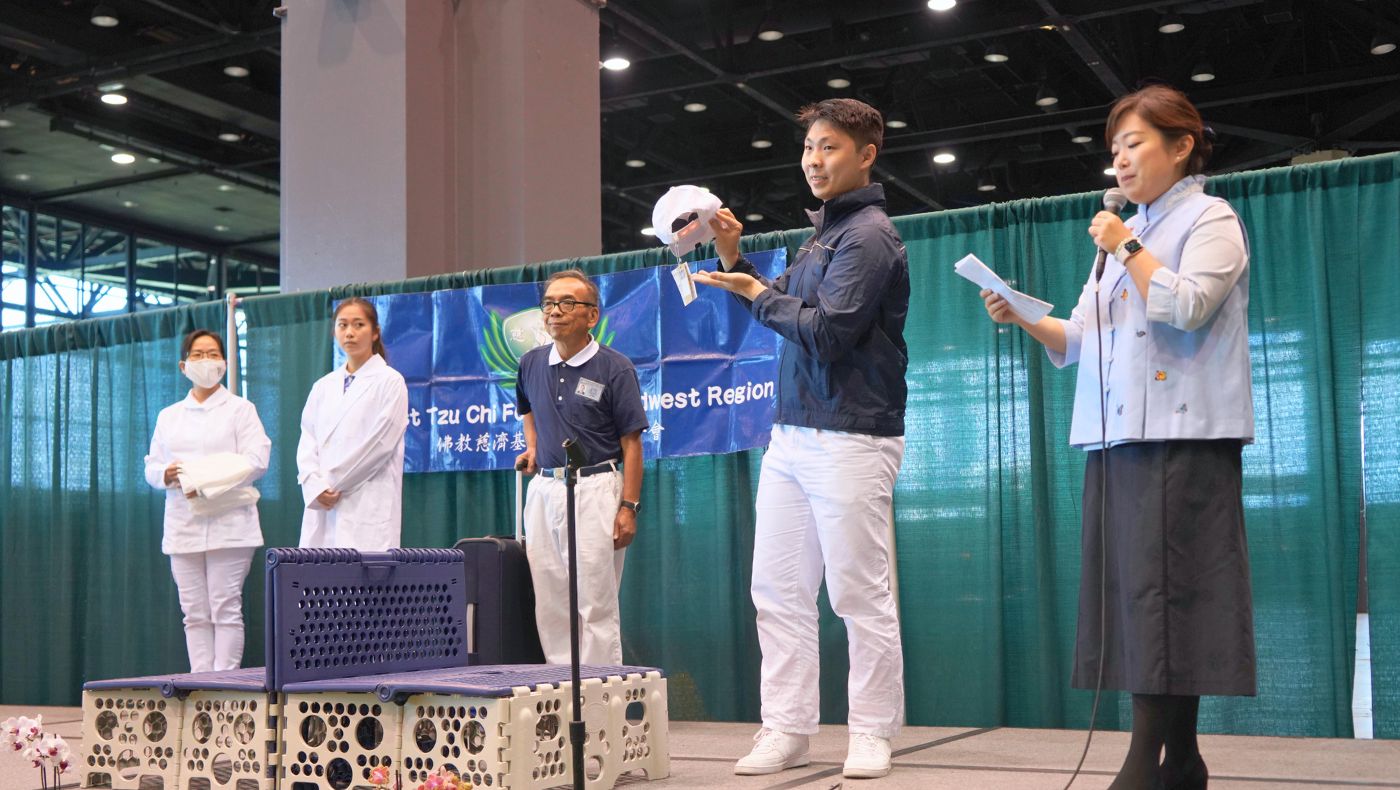
“Volunteers’ safety is Master Cheng Yen’s highest priority. To better protect ourselves, she designed several products based on our needs to ensure everyone’s safety,” Chow said. These include solar-powered caps that can provide a source of light in the dark; sneakers that are water repellent and reflective, with a sole that protects against sharp objects; lightweight, reflective, and water repellent disaster relief jackets; a suitcase with built-in weighing capabilities; and multi-purpose sunglasses.
With functional needs in mind, Tzu Chi also created a special DA.AI partition for medical outreach. As volunteers demonstrated, one can set it up and put it away in a few seconds, and it offers doctors and patients the privacy they need during a medical exam. Moreover, the solar-powered caps are also beneficial in these circumstances, as doctors can use the light from the hat to examine patients. And DA.AI compression socks can help blood circulation for medical staff on their feet all day.

Chow and the volunteer team then demonstrated sustainable practices like Tzu Chi volunteers bringing Environmental Protection Kits everywhere they go. These usually include a bowl, small cup, and utensils, reducing consumption of single-use products. The show also featured school supplies and clothing to raise awareness among younger generations. The school supplies have labels showing how many plastic bottles or caps were used in their making, and the T-shirts have images of different endangered animals printed on them to inspire youth to be more mindful of their clothing choices and help them not fall prey to fashion trends. However, that message did not only aim to reach youth, as the show also presented casual and work clothing for adults.
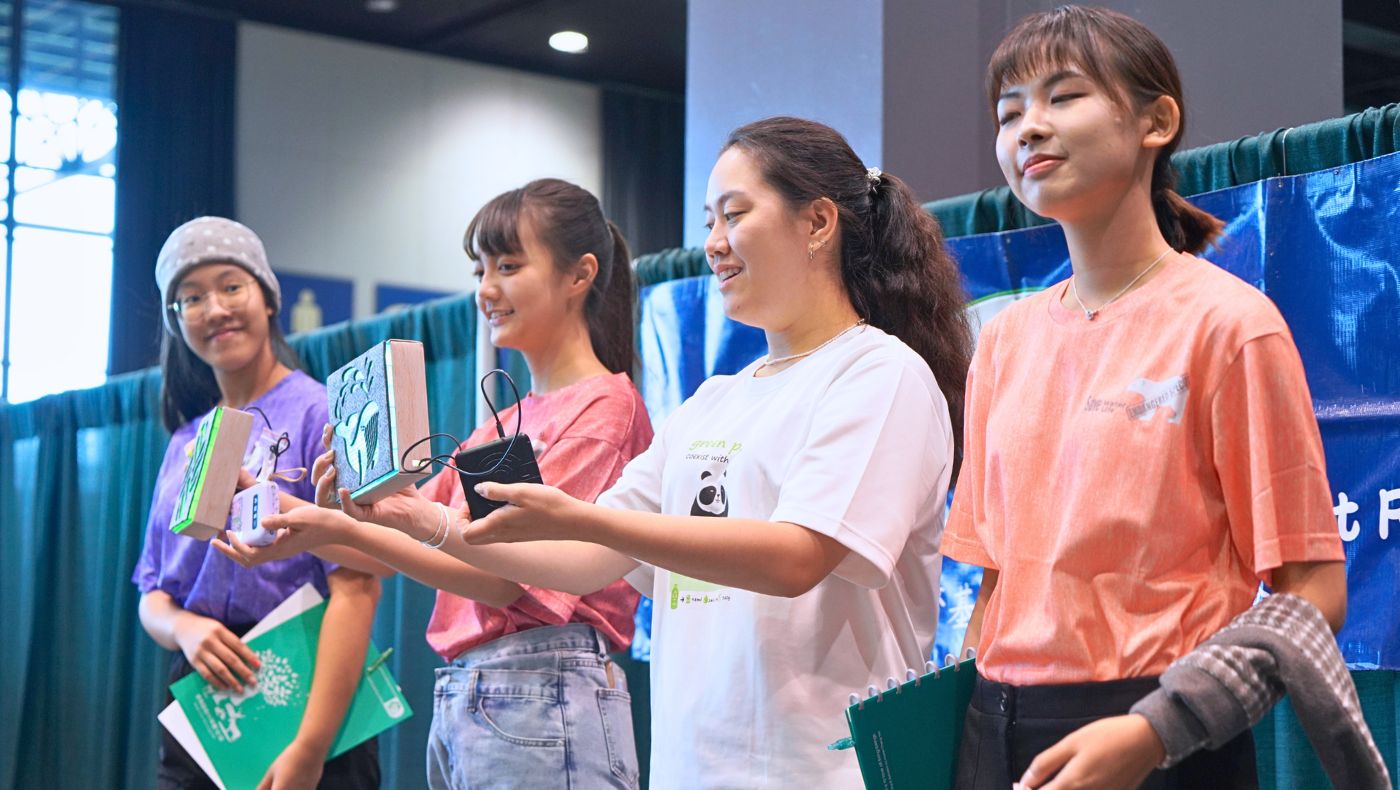
A sustainable lifestyle is something we want to advocate for all generations. Let’s opt for quality over quantity. Investing in well-made pieces not only benefits our personal style but also reduces the demand for excessive production. Remember, our choices extend beyond our closets. The rapid production and disposal of cheap clothing items contribute to pollution and waste, leaving a significant carbon footprint. It’s time we reevaluate our relationship with this unsustainable trend and consider its broader implications. By choosing to reduce, reuse, and recycle, you’re not just living sustainably; you’re shaping a more mindful and responsible world that values both our environment and our future.
Annie Chow
Tzu Chi Volunteer
One of the session attendees was eager to share her reaction to everything she saw, saying:
The products look beautiful. The thing I found most amazing was the bed. I’ve seen a lot of disaster relief where people were sleeping on the floor. It’s so much more helpful to have the bed, the chairs, and things to sit on. The shoes! I can’t believe they’re plastic. It’s so well thought out, and so creative, so practical. This is the kind of mentality that we need to share in the world. It’s holistic. I was very impressed.
Manohara Ferretti
Interfaith Minister
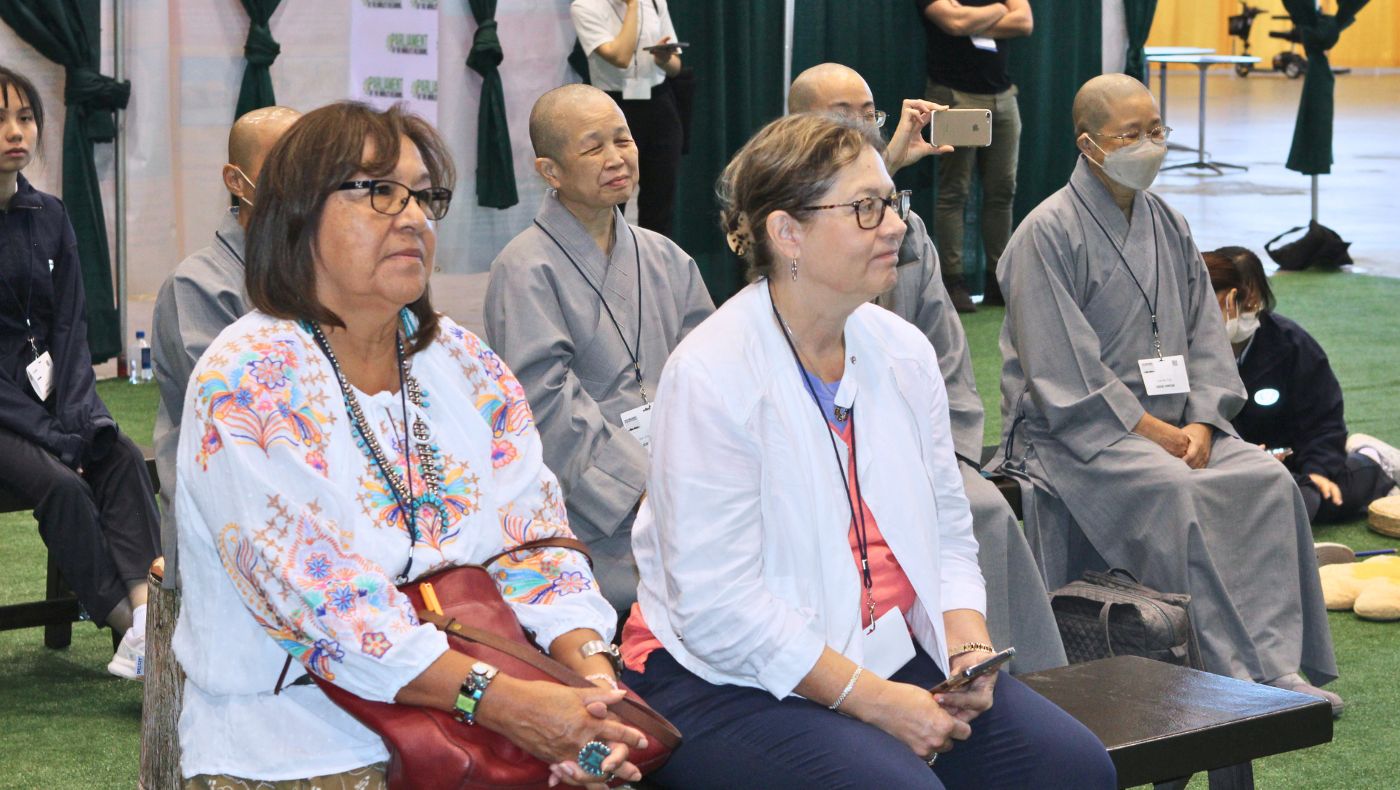
Green Buddhism: Turning Trash Into Treasure
To boost Tzu Chi’s environmental message, all week at the children’s booth, Tzu Chi volunteers and university students organized activities to build environmental awareness, taking kids through the lifecycle of plastics and drawing attention to plastic-related challenges. The children had hands-on experience transforming plastic trash into artwork and ornaments.
We stopped at the children’s booth and just started hearing about [Tzu Chi] and what they do, and I was just blown away by the mission and all the activities. I find so much that I get from stores is wrapped in plastic in some shape or form. It kind of stresses me out; so much accumulated so quickly. So it’s really inspiring to see somebody taking action about that.
Ashley Pelli
Tzu Chi Children's Booth Visitor
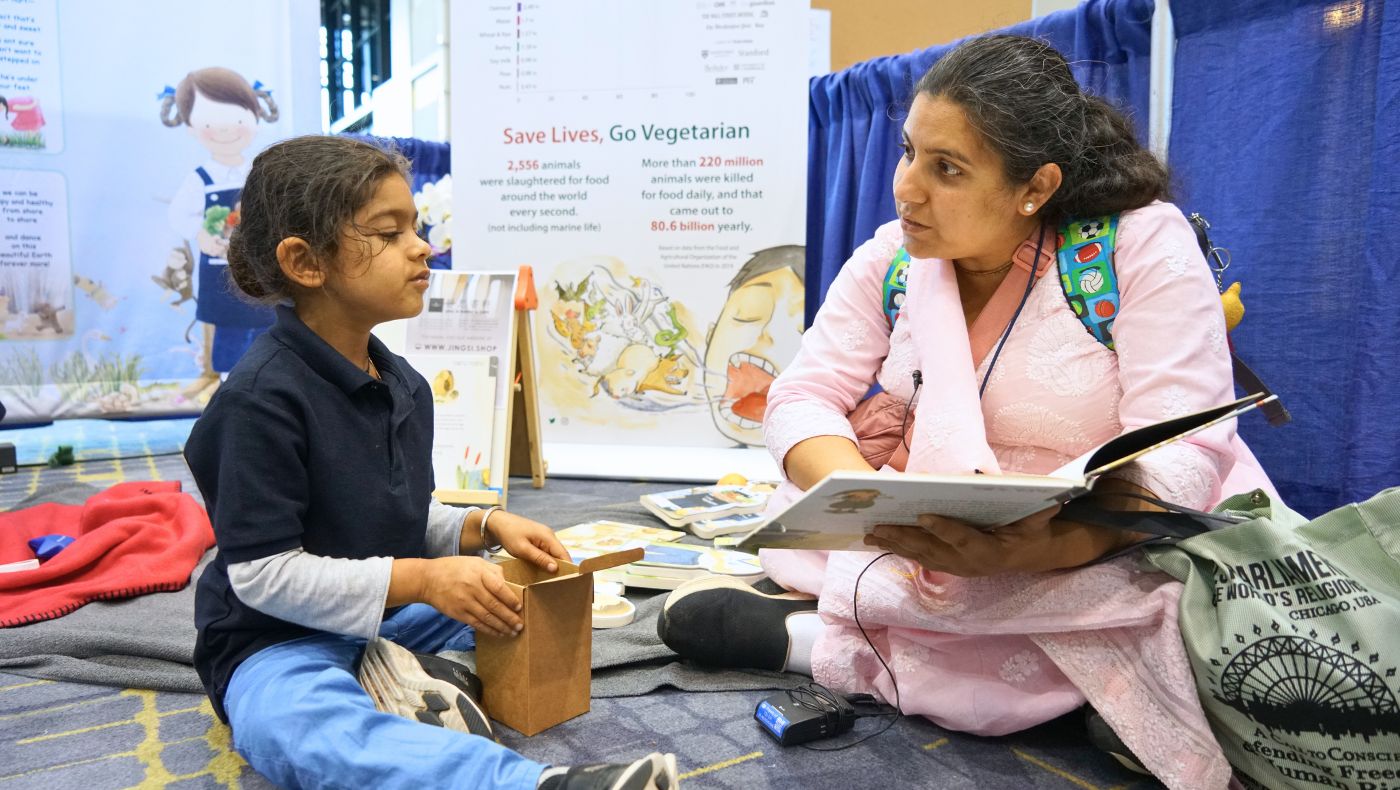
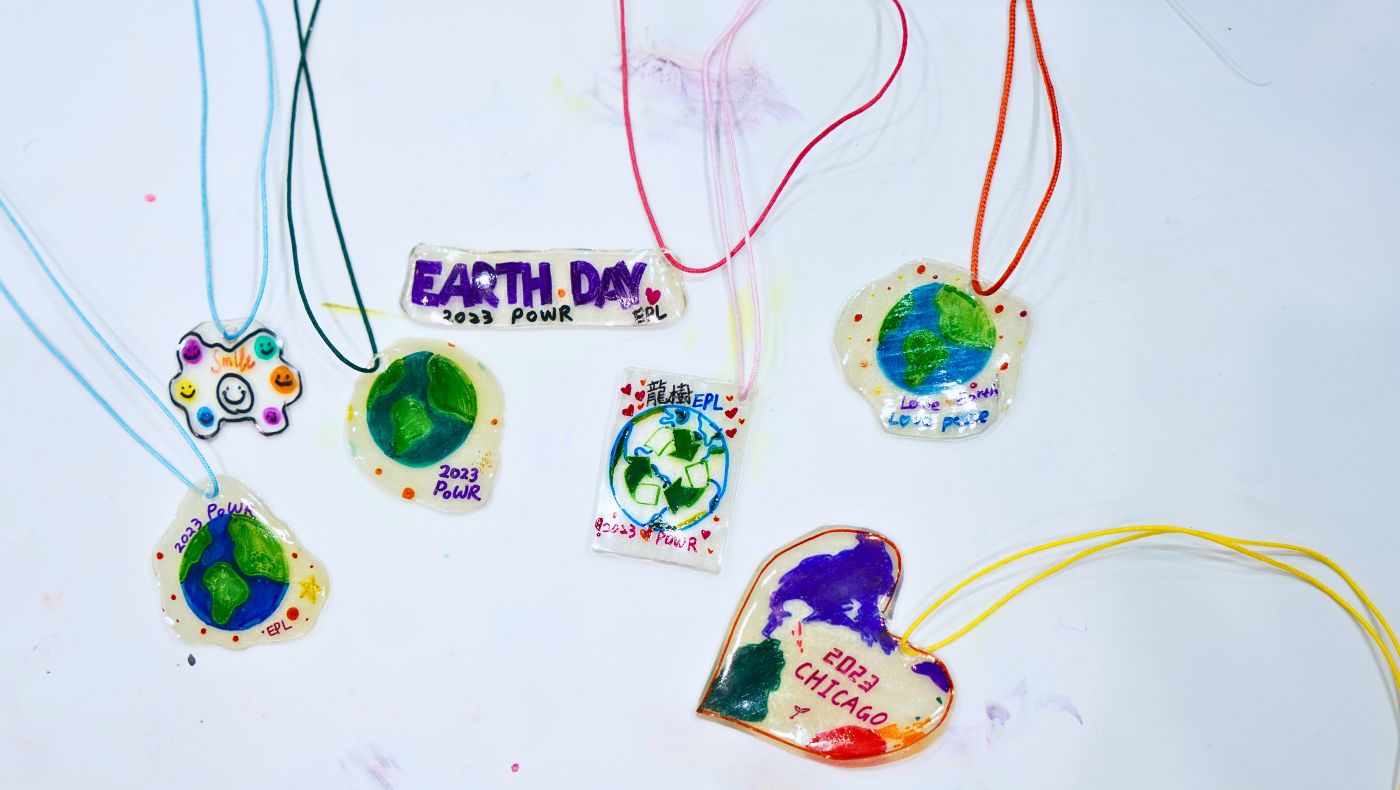
At the Children’s booth. Photos/Daniel Ferrara
“Greening of Congregations: The State of the Movement | Part 2”
The “greening” of houses of worship of many faith traditions has become an international movement. The shift to environmental sustainability focuses on such practices as adopting renewable energy, energy conservation, diet and food production, reducing plastic, waste management, and plants and trees on land belonging to the congregation. It also includes education in the teachings of the community’s religion on the vision and values of our relation to the natural world and integrating these teachings into liturgy, prayer, and study.
In this panel, moderated by Laurel Kearns, co-founder of the Green Seminary Initiative and Professor of Ecology, Society, and Religion at Drew Theological School in New Jersey, international speakers from different faith traditions presented the programs and initiatives of their religious communities and organizations.
Rabbi Daniel Swartz, Executive Director of the Coalition on the Environment and Jewish Life and the spiritual leader at Temple Hesed of Scranton, began the discussion and asked everyone to close their eyes and envision the first image that comes to mind when hearing the word environment. “Now open your eyes and raise your hand if there were any people in that picture,” he instructed, and only a few did. “I’ve been doing this for 30 years, and I’ve never had more than a handful of hands up,” Swartz said.
This is one of the fundamental problems, that we think of the environment as something out there, whales and wilderness, when in fact, everywhere we are, this room that tries to separate us from the world is part of the environment. As long as we think of the environment as something out there, disconnected from us, we won’t understand how everything we do affects our environment and how, in turn, everything that happens in the environment impacts us.
Rabbi Daniel Swartz
Executive Director
Coalition on the Environment and Jewish Life
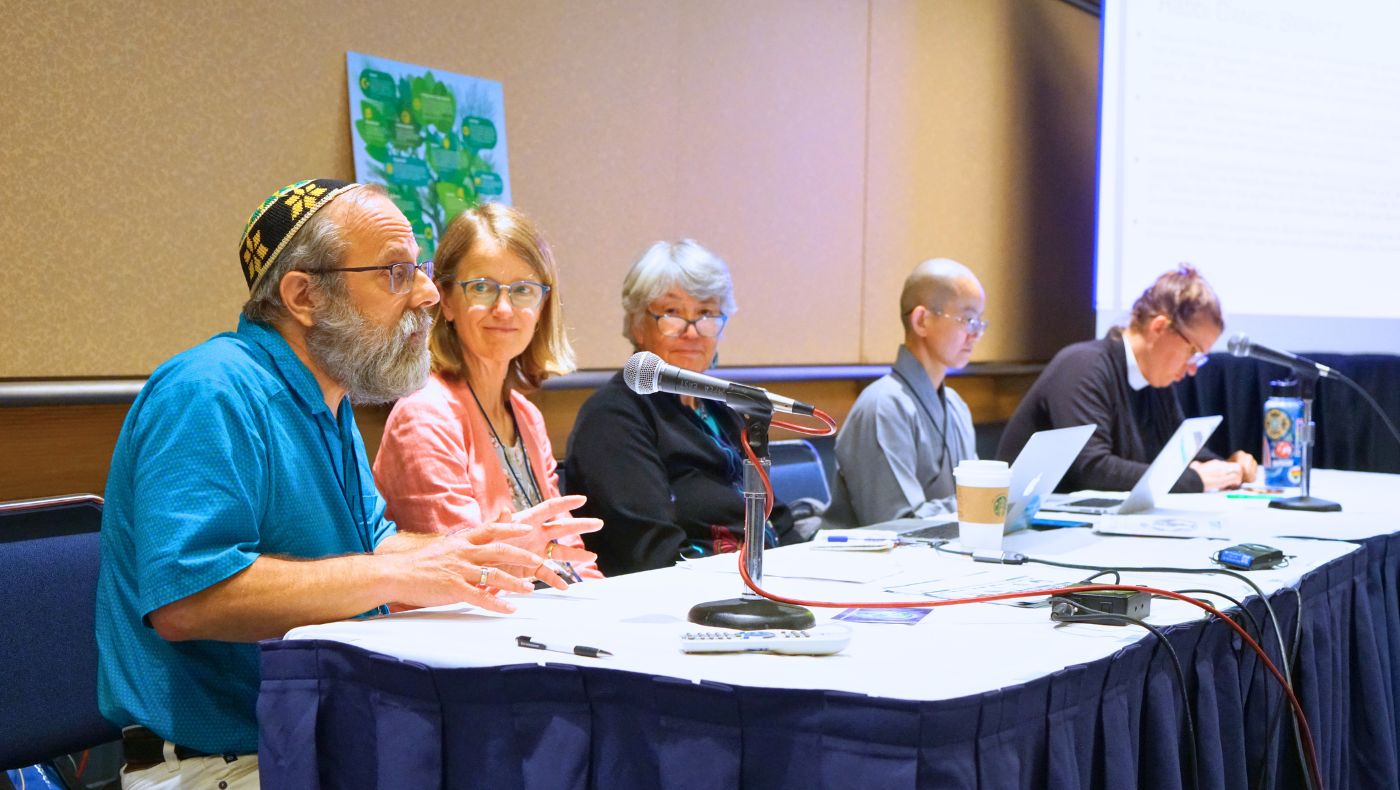
Swartz spoke of how we need to think of greening congregations as a set of several concentric circles: “At the core, it’s what you physically do to the building. But a congregation isn’t just the building; it’s the people. And you have a multiplier effect if everybody in the congregation is doing in their home what you’re doing in the building. So that second circle is all the people associated with the congregation. And the third circle, you need to make sure that you don’t hide your light under a bushel.”
We need to be changing laws and not just hearts. Individual acts and actions are not enough if we don’t get societies moving in the right direction. And so, a fundamental part of greening is to be an advocate. You have a call to speak beyond your community.
Rabbi Daniel Swartz
Executive Director
Coalition on the Environment and Jewish Life
Ven. Shih De Cheng spoke next and began by outlining how Tzu Chi’s recycling mission started in 1990 after Master Cheng Yen saw a street full of garbage and called for individual action. By recycling, one can also reflect on our consumer habits and “gradually reduce our desires and consumption for the sake of the world.”
Master often teaches that as people with a compassionate heart, we must never forget to show compassion and love to our earth. Faced with the gradual destruction of the environment, the need for humanity to awaken is imminent.
Ven. Shih De Cheng
Jing Si Abode
De Cheng shared that Tzu Chi has joined the race to NET Zero by developing a plan to reduce its carbon emissions, hoping to reach the NET Zero goal by 2050. But before explaining the many greening aspects of the Jing Si Abode where Master Cheng Yen resides, De Cheng spoke of how Master Cheng Yen is a powerful example, “Apart from advocating for others to live an environmental lifestyle, she herself also lives a life of great simplicity.” She uses one basin of water per day for all her needs and will use the same sheet of paper four times, writing first with a pencil, then blue pen, then red, and finally a brush. “She truly practices what she preaches, how to save resources in everyday life.”
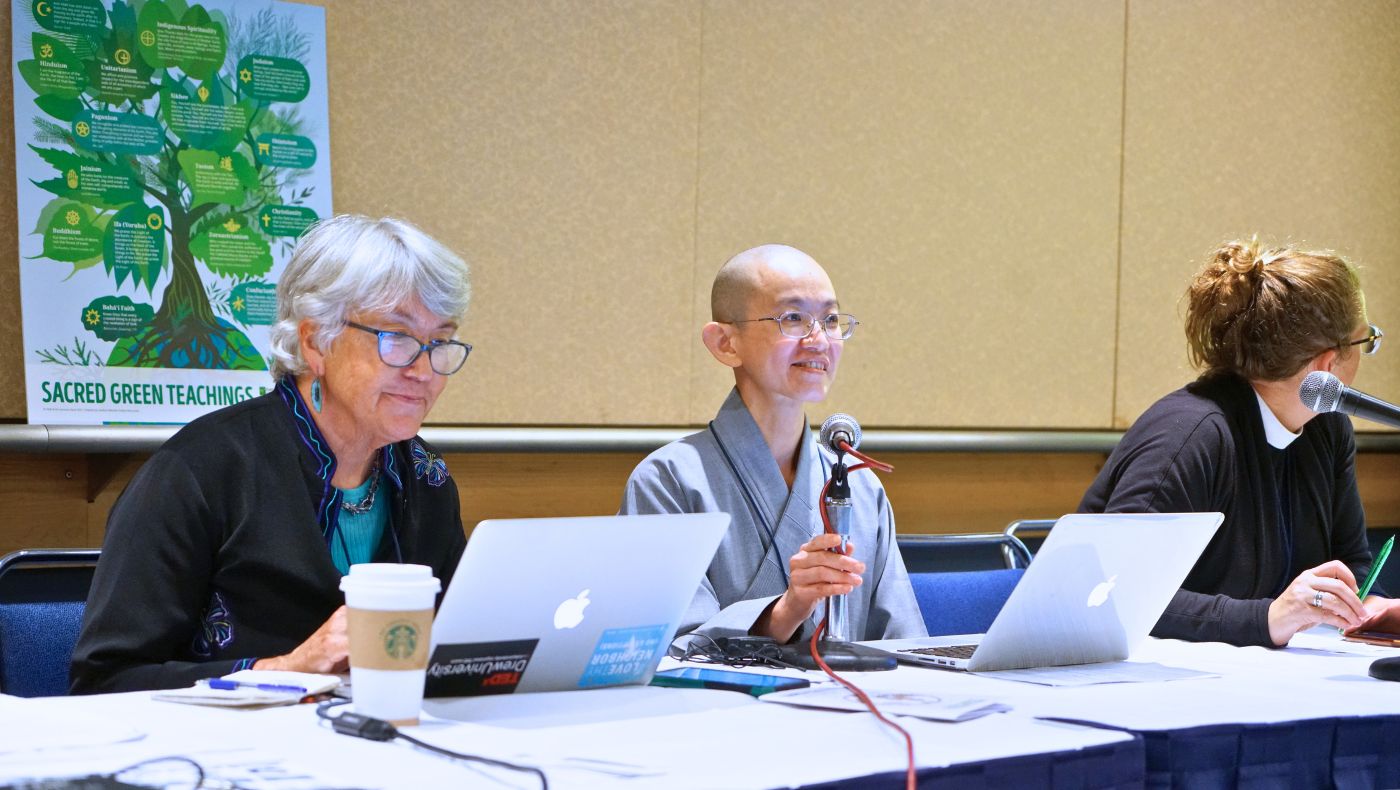
De Cheng described how the monastics at the Jing Si Abode also follow Master Cheng Yen’s life principles: “We reduce, reuse, repair, and recycle. We eat only plant-based food and turn food waste into fertilizer and enzymes that go back into the field we use for food production, growing vegetables and plants. We use electricity sparingly and pass the hot summer without air conditioning except in the computer room, meeting room, and food factory. And if our clothing wears out, we patch it to minimize textile waste.” The nuns repurpose objects, too; for instance, canisters for cooking oil become dust pans.
The Abode also puts a lot of effort into using water as efficiently as possible, with modified dishwashing troths that reuse water over several rinses. And the buildings themselves have many multifunctional, environmentally friendly, and energy-saving features. These include the choice of materials used and design aspects.
Wood grating in the ceiling introduces sunlight into the main hall because we use light and shadow to reduce energy consumption and environmental performance. This permeable wood grating allows hot air to rise and cool air to enter to achieve energy saving and carbon reduction. As to the ecosystem in the Abode, we also have natural-based solutions, such as rain catchment and a storage system. We have two ecological pools and one detention basin to allow rainwater to flow naturally, enabling flood protection and water security.
Ven. Shih De Cheng
Jing Si Abode
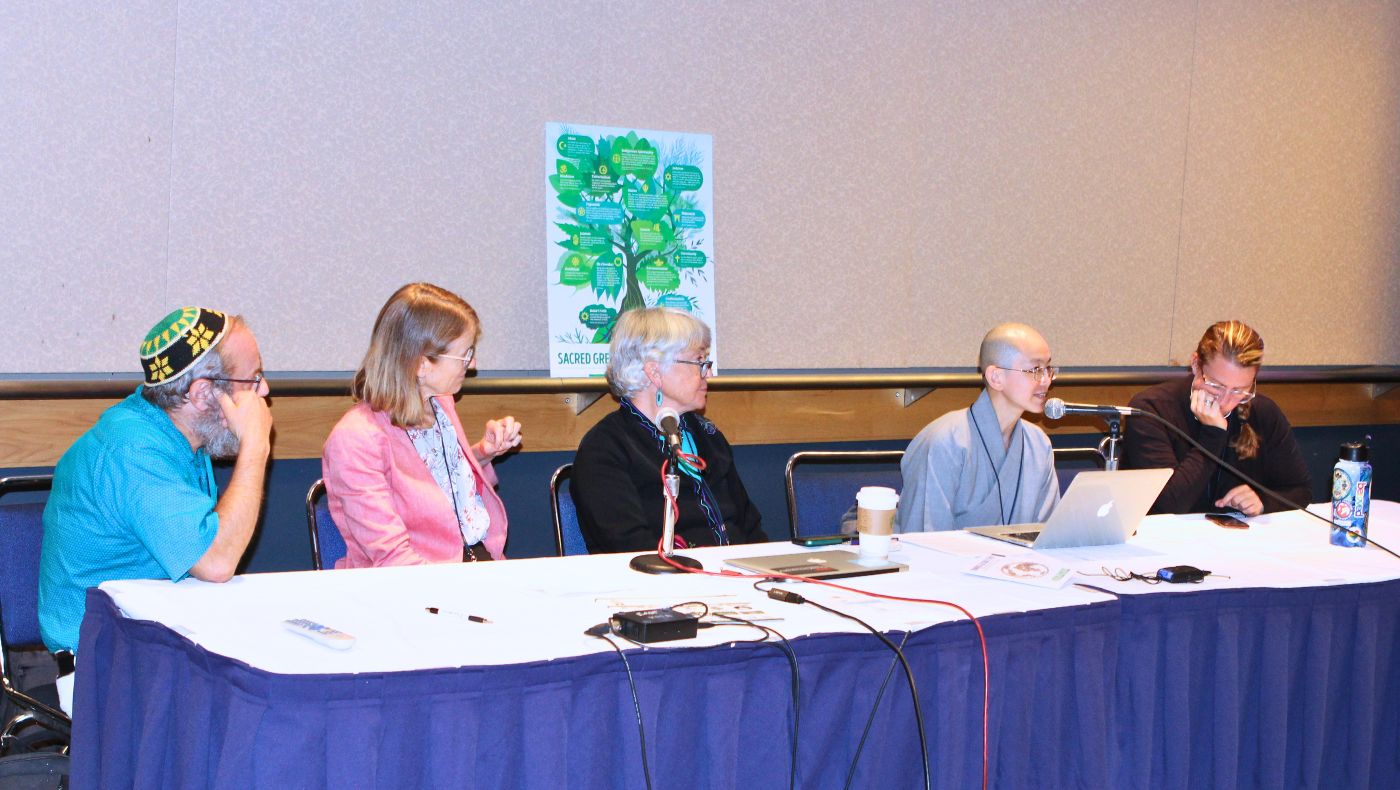
De Cheng ended by explaining that Master Cheng Yen also emphasizes the importance of spiritual environmental protection, a key aspect of which is adopting a plant-based diet. “By abstaining from practices that cause suffering and death for living beings, we grow our compassion. By reducing demand for meat, we reduce the negative environmental impacts of livestock farming, a main driver in all three aspects of the planetary crisis, climate change, pollution, and biodiversity loss.” However, the race to reach environmental sustainability is urgent even with all these measures.
As of today, according to the Climate Clock, we just have five years and 339 days left to take action to prevent the worst effects of global warming from becoming irreversible. Especially at this moment, it is time to wake our inner conscience and turn green thoughts into action, and take actions to protect the Earth.
Ven. Shih De Cheng
Jing Si Abode
Sarah Paulos, the Community Engagement and Programs Manager for Interfaith Power and Light, was the next speaker and described how she was awakened to climate action when they proposed to build a huge coal-fired power plant in her community in Iowa, which led to the creation of the Cool Congregations Program.
My girlfriends and I heard about the proposed 750-megawatt coal-fired power plant to be built in our community. Their kids have asthma, and the emissions from coal-fired power plants can trigger asthma attacks. So we all went to the protest and put up signs in our yard. And one day, my neighbor saw my yard sign saying, ‘No Coal,’ and said, ‘If you really want to do something, you’ll reduce your electricity use because they’re building that plant to meet consumer demand. And so [we] organized a program to help our congregation’s members reduce their energy use at home.
Sarah Paulos
Community Engagement & Programs Manager
Interfaith Power and Light
Overall, Interfaith Power and Light (IPL) is helping green congregations across the United States. “Our mission is to inspire and mobilize people of faith and conscience to take bold and just action on climate change,” Paulos said, “As part of that vision, IPL invites congregations to reduce the emissions from their worship facilities that contribute to climate change as an act of faith. There are approximately 400,000 houses of worship in the United States; this represents tremendous potential to contribute to carbon emissions reduction goals for our country. [In] our worship facilities, we can cut costs, care for our sacred earth, and care for our neighbor. It’s a win-win-win situation.”
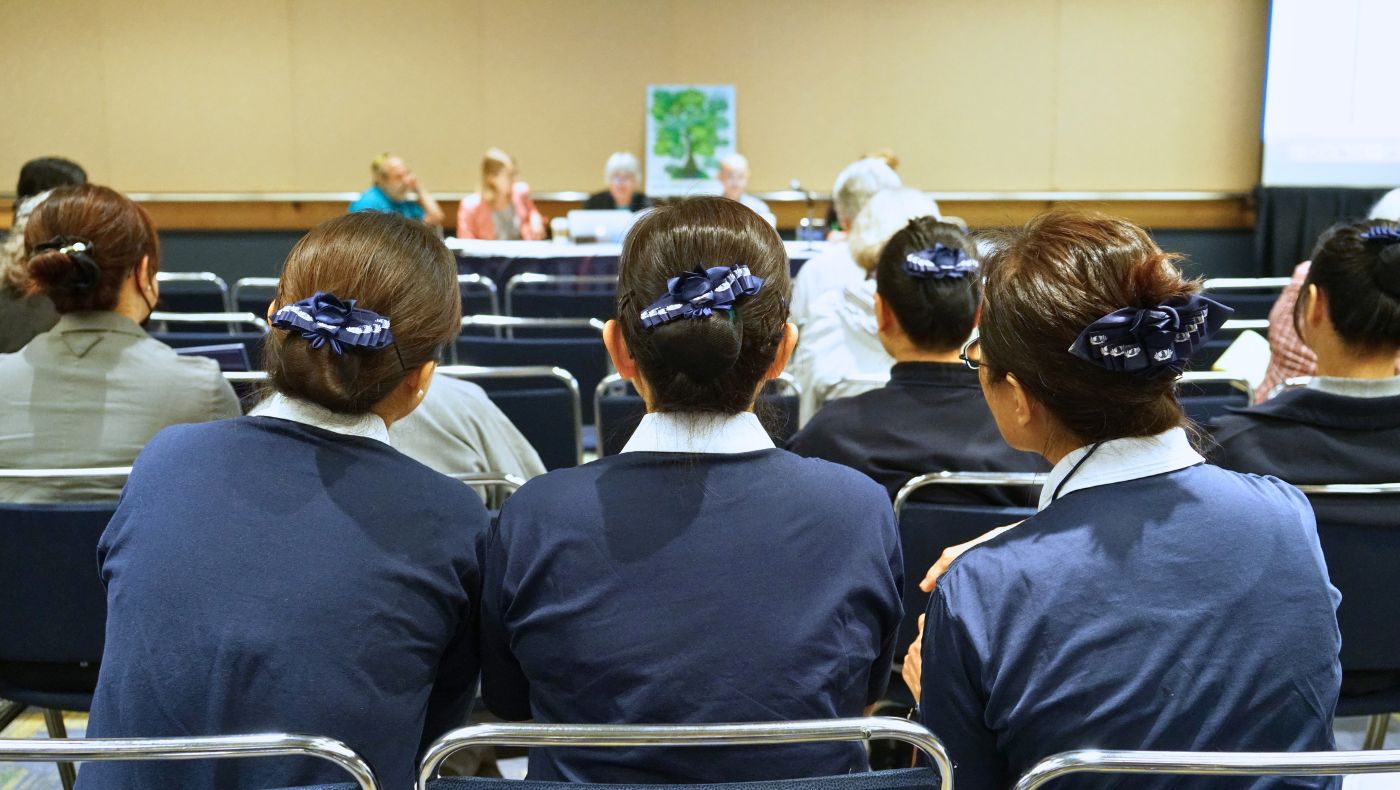
Interfaith Power and Light offers a variety of resources to congregations to cut their emissions through the Cool Congregations program, including a startup guide, carbon emissions trackers (one for congregational facilities and one for households), a solar financing guide, and two programs to acknowledge congregations that have achieved success in reducing their impact on the environment, such as certifications and various challenges with cash prizes.
In the last three years, Interfaith Power and Light has recorded 118,000 tons of carbon dioxide reduced by participating in congregations. Together, we can have a huge impact.
Sarah Paulos
Community Engagement & Programs Manager
Interfaith Power and Light
Rev. Abby Mohaupt, Director of Education and Training at GreenFaith and an ordained minister in the Presbyterian Church with 20 years of organizing and teaching experience in faith-based environmentalism, spoke next. “Green Faith started in the early 90s in response to the need in New Jersey to gather faith leaders to talk about how their faith communities could be more green,” she said, “so we started as a nonprofit that helped communities change out light bulbs, dig into their religious texts about Earth care, and do some New Jersey-based policy.” Over time, they expanded nationally and internationally.
She recounted that after significant reflection in 2018, they had somewhat of a rebirth around organizing people of faith in grassroots communities to respond to climate and environmental injustices. “The original work of training congregations and people of faith to work in their communities shifted from more traditional greening congregations to system change and [the creation of] over 100 green faith circles [that] respond to how the fossil fuel industry [and] deforestation are affecting their communities, [and organize] to determine responses to climate emergencies on the ground and in their work.”
Mohaupt then donned her Presbyterian hat.
The Presbyterian Church USA has always been embedded in caring for creation, which is how we as Christians talk about the natural world. We’ve lived into this biblical teaching of how we’re called to love God with our whole selves; with our hearts, and our minds, and our souls, and all our strength. And that teaching has shaped how we as a branch of Christianity have thought about our ecological commitments in the world. We talk about how worship needs to engage ecological issues, climate justice, and environmental justice.
Rev. Abby Mohaupt
Director of Education & Training
GreenFaith
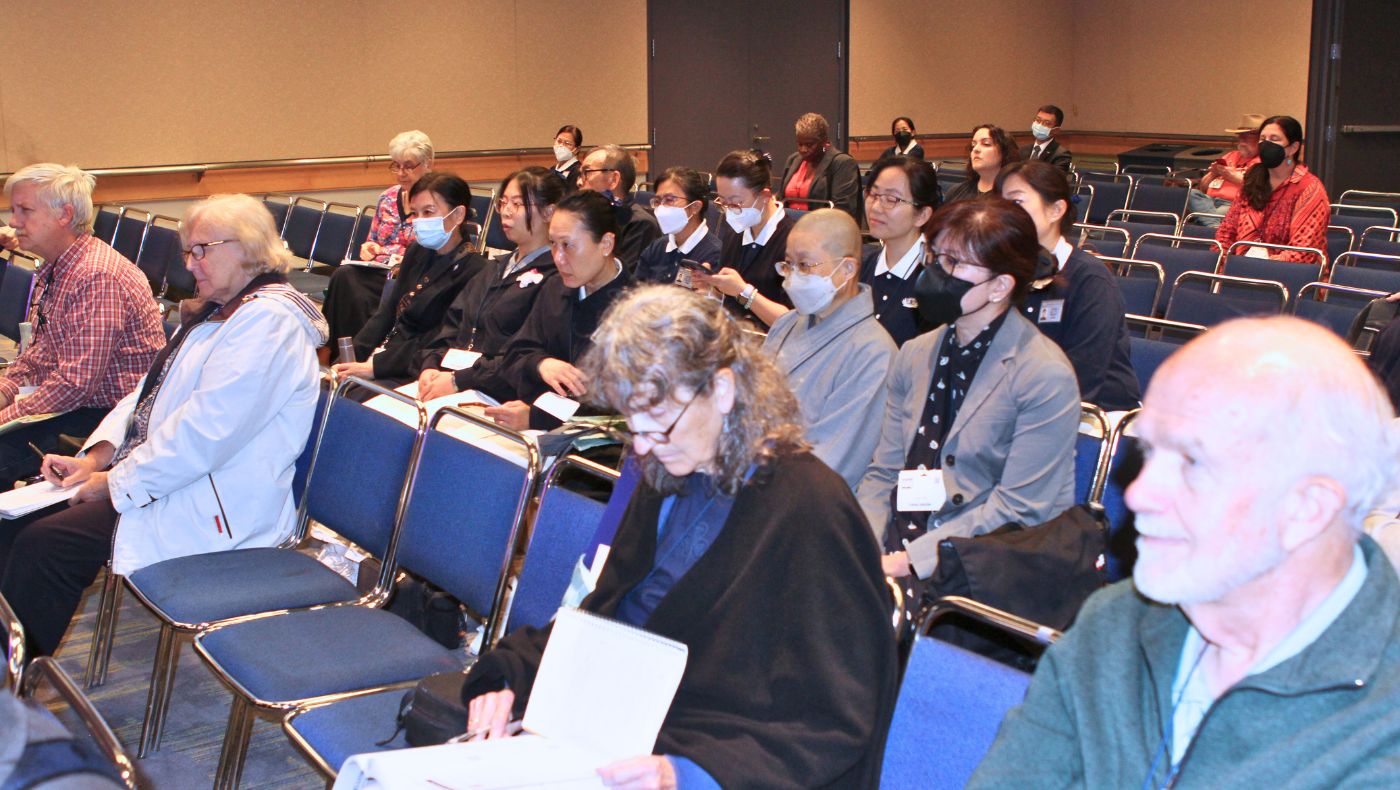
In 2014, the Presbyterian Church USA created a greening congregation initiative called the Presbyterian Earth Care Congregation Program, and since then, over 300 congregations, the largest of which has 5,000 members and the smallest of which has eight members, have been certified as Earth Care Congregations. However, the certification also requires congregations to engage in system change.
We can’t survive the crisis we’re in unless we really change the system and the culture around us as we shift and try to be resilient in a new climate-changed world.
Rev. Abby Mohaupt
Director of Education & Training
GreenFaith
“A Wealth of Collaborations: Translating the Parliament's Global Ethic Declaration into Chinese”
Adopted by the PoWR in 1993, the Global Ethic is a widely collaborative expression of the fundamental ethical commitments already shared by the world’s religious and non-religious people. A team of professional English-to-Chinese translators led by PoWR Trustee, Debra Boudreaux, recently made it possible for the Global Ethic’s commitments to be accessible to all whose written language uses Chinese characters. During this session, Debra Boudreaux, Tzu Chi USA CEO, and Dr. Rey-Sheng Her, Deputy CEO of the Buddhist Tzu Chi Charity Foundation, discussed the challenges and opportunities encountered during the work of translation.
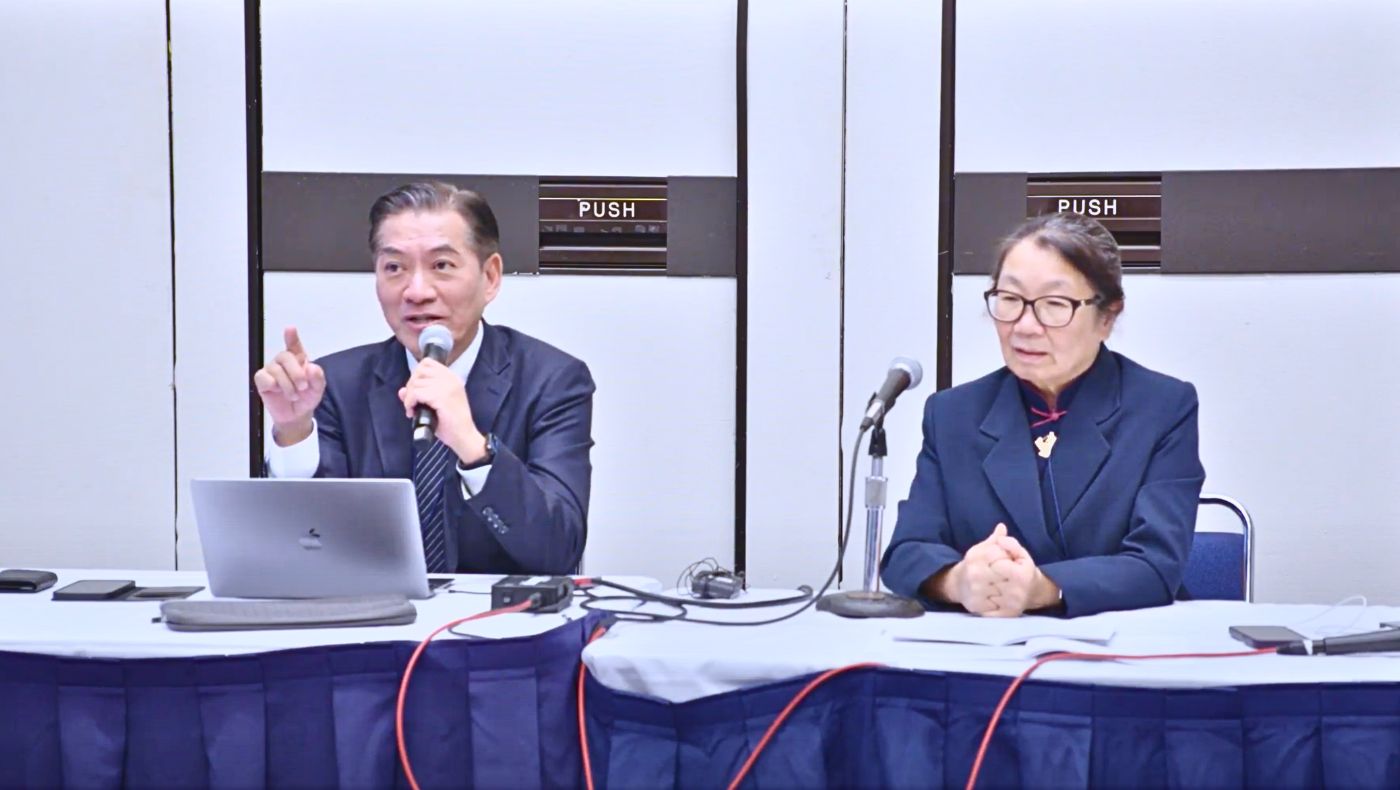
“Women’s Perspectives on the Global Ethic”
In this final session of the day, moderated by Sharan Kaur Singh (Sikh), a Trustee of the PoWR, four fellow female Trustees shared their perspectives on the Global Ethic (An Initial Declaration), the PoWR’s signature document written in 1993. Each panelist represented a different religion: Mary Doak, Roman Catholic; Sahar Alsahlani, Muslim; Ven. Shih De Huang, Buddhist; and Mahrukh Motafram, Zoroastrian. Additionally, all the panelists serve on the PoWR’s Global Ethic Committee.
To begin, Singh highlighted that the Global Ethic, a document the PoWR completed 30 years ago, in 1993, is “an important and valuable place from which to start conversations about the moral values and principles that matter to us all; it is a courageous attempt to focus on what we human beings share on the moral ground we have in common.” She later shared her own faith perspective:
The Sikh religion teaches us that we are all children of one God, and women possess an equal right to cultivate their spirituality with chances of achieving salvation equal to men. Our first guru mentioned that in his writings, he said, ‘How can you call a woman bad? From her, kings are born. From woman, woman is born. And without woman, there’d be no one at all.’ So, he was far beyond his time; this was over 500 years ago. But today, we need to reassert our rights as women. We have to fight for it. And if we were not to do that, society will suffer, and so will future generations.
Sharan Kaur Singh
Trustee of the Parliament of the World's Religions
Member of the Global Ethic Committee
In their sharing, the women presented their faith views on why gender equality is vital and how the different faiths address it.
Ven. Shih De Huang revealed that in the 1960s, which is when Ven. Dharma Master Cheng Yen founded Tzu Chi, most people thought raising a family was the most significant asset for women. However, she believed women could contribute to the world’s affairs outside of gender role expectations, and she encouraged her first followers, who were female, to put compassion into action and to become living Buddhist Dharma practitioners.

While Master Cheng Yen’s first five monastic disciples took self-reliance as a principle of practice and were ready to sacrifice themselves and endure many hardships, her lay followers, 30 local homemakers, helped fund the charity works with daily donations, pennies a day saved from their grocery money, in handmade bamboo banks. People learned of the mission to help relieve suffering and began contributing. Moreover, “among the first Tzu Chi committee members, women accounted for about 60% of the member body,” De Huang explained.
In Master Cheng Yen’s Tzu Chi Dharma lineage, everyone can do good and benefit the world. When she first proposed the system of pure practitioners, a group of lay followers who devote themselves to the Tzu Chi mission with pure cultivation, dedicating their lives and taking on additional vows and precepts, she didn’t differentiate between men and women. The lay followers are the equivalent of monastics without the need to shave their head and must behave just like monastics by following the precepts. They see the Jing Si Abode as their spiritual home and all sentient beings as their family.
De Huang shared that one female Tzu Chi volunteer in Taiwan is 105 and still active, “safeguarding our environment for more than 30 years, through working at the recycling stations. She is just one of the thousands Master has empowered to enhance their life value and develop themselves,” De Huang said. During international relief work, Tzu Chi also uplifts female care recipients through education and vocational training, freeing low-status women from a cycle of poverty and helping them regain self-confidence, self-esteem, and empathy for others.
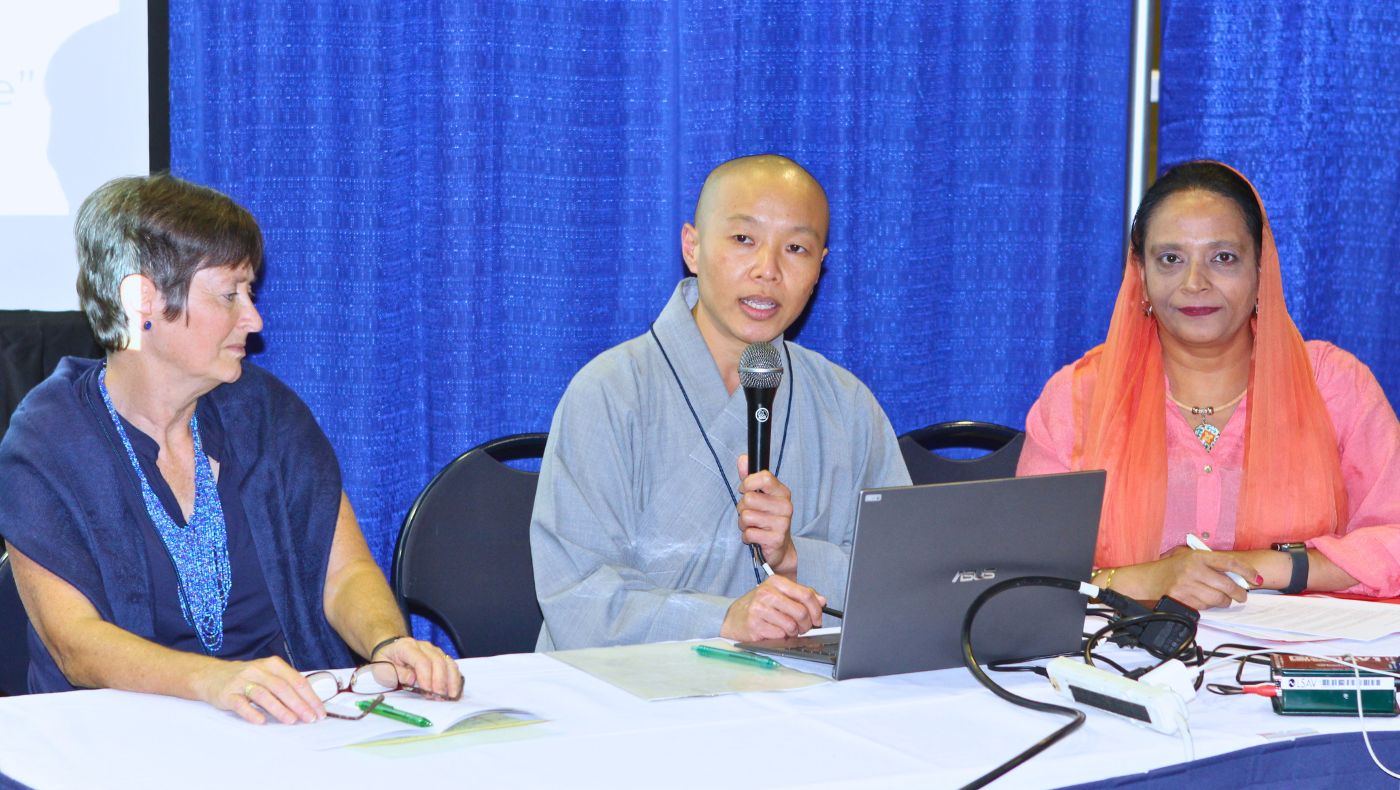
Additionally, the top executive director roles in Indonesia, Malaysia, and the USA, the three largest Tzu Chi overseas chapters, are currently held by women. “As people say, responsibility can inspire a person’s potential and awaken their conscience,” De Huang said. From her narrative, one could see how Ven. Dharma Master Cheng Yen didn’t wait for permission but stepped outside gender roles and forged a path that continuously inspires women near and far.
The meaning of life is not about how long we live; it’s about the depth of our life. The Buddha said the human form is rare to attain. As for this body we’ve attained, we don’t have permanent ownership but only the usage of our body as a vehicle. So we must walk on this path, life after life. Our contributions might look trivial in the grand scale of things. Still, day by day, little by little, accumulating our efforts has influenced innumerable amounts of people who, in turn, extended their life and love to others.
Ven. Shih De Huang
Jing Si Abode
Dr. Mary Doak, who teaches courses in Christian theology at San Diego University, where her research focuses on the political and practical implications of Christian faith in the contemporary United States, said she had asked herself: To what extent is the global ethic gender inclusive? In reflection, she saw, “It’s a common ethic, and it speaks to common concerns, common issues, common suffering, and a common ethic to address that.”
Doak then had two insights to share. “Underlined in the global ethic’s five directives is a sense of the interdependence of human beings with the planet, each other, and all that is. These directives point us back to restoring and healing that interdependence. Women have tended to embrace interdependence; there’s certainly a general sense that women will tend to appreciate that inter-relationality,” she stated.
Her second insight related to the work of the eco-feminists, “who noted that the connections between the oppressions of women, of people, of racism, sexism, and abuse of the environment were deeply interconnected. And that’s come to be specified in a form of critique of what’s sometimes called hierarchical dualism, or a hierarchical binary thinking.”
Doak elaborated, “Everything is in relation, but things are separated into two categories, and one is valued over the other. Men over women, human over nature, white European over people of color, spirit over body, God over world. And one of the things that a lot of women have lifted as needing to be healed is hierarchical dualism.”

As a Catholic, Doak asked for thinking about “the tradition’s most ultimate concepts of the divine, and how God becomes equated with male, with white, with spirit over the categories of world, nature, creation, women, etc.” She cautioned that when we treat dominant veil perspectives as universal and when women’s voices are left out, the solutions to global crises don’t always fit women’s situations and needs.
Women do most of the world’s work and receive less of the world’s resources. Women and their children are definitely the majority of the poor in the world. There’s a call to remember differences and the need to be involved in the diagnosis of the problems, the construction of the solutions, and the implementations of the solutions, or the solutions will not work. My point is not just to include a single essential feminine perspective, an essential male perspective, but to acknowledge the plurality. And the plurality diversity is a good and a strength that we need to foster as we seek to create a world that will work for all of us to heal the global crisis of economics, ecology, and politics.
Dr. Mary Doak
Professor
San Diego University
Mahrukh Motafram, Co-Chair for the North American Zoroastrian Congress committee, spoke next and revealed that the search for a common ethic is ancient. “Every religion and tradition has fundamental core values. Even in the most ancient of them, these fundamental principles already exist. My faith is a perfect example of that,” she said. In the Zoroastrian faith, in 539 BCE, Cyrus the Great, who ruled the expansive Persian Empire, conquered Babylon and then made an edict or proclamation to preserve human rights in cities and regions under his rule.
The following example of an ethic Motafram spoke of was the United Nations’ proclamation of the Universal Declaration of Human Rights after World War II in 1948, “an indication that a document is necessary to remind us how important it is to treasure, preserve and sustain our peace, dignity, and equality on the healthy planet.” And now, we have the PoWR’s Global Ethic.
We see our world, our Earth in pain, filled with lies, hatred, abuse, aggression, giving rise to economic and social inequalities, poverty and above all an existential threat to our Earth's ecosystem. Yes, all this is true and it doesn't have to be that way. This document gives us a roadmap, a direction, a journey we can embark upon together, a way of life where we live in peace and harmony for the preservation of our surroundings on Earth, respectful and grateful for our existence and all living beings.
Mahrukh Motafram
Committee Co-Chair
North American Zoroastrian Congress
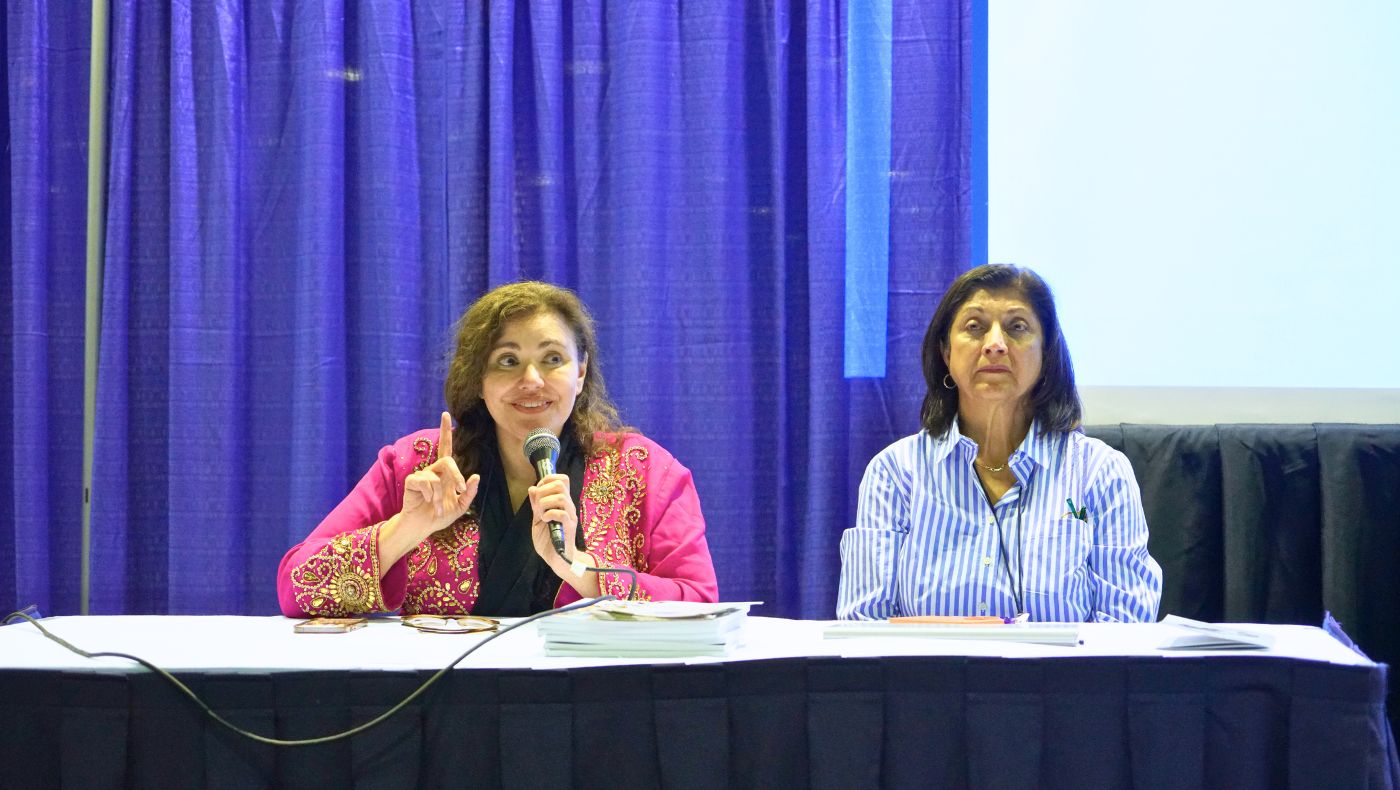
Sahar Alsahlani, co-chair of The Fellowship of Reconciliation, an interfaith organization, represented the Islamic perspective in her sharing. “When I look at the global ethic, I kind of wonder if it actually encompasses everything that Islam has to offer women in their perspective and their rights,” she said, adding, “A lot of times, Islam is often targeted for being anti-woman or the patriarchal religion inherently, and it has often gotten a very, very unfair wrap with regards to that. I personally find Islam a religion that liberates me and gives me a lot of moral agency with regards to how I live my life in a very protective way.”
She spoke of sections in the Quran that protect women’s rights to education, their rights in marriage and divorce, and other circumstances and aspects of life.
One of my favorite quotes is one of the very last quotes revealed to Prophet Muhammad from the angel Gabriel. God states, ‘I shall not lose sight of any of you who labors in the way of my cause, whether it be man or woman, for each of you who is equal in the sight of me.’ We believe in the afterlife and heaven or hell. So basically, God judges us equally on our deeds.
Sahar Alsahlani
Co-Chair
The Fellowship of Reconciliation
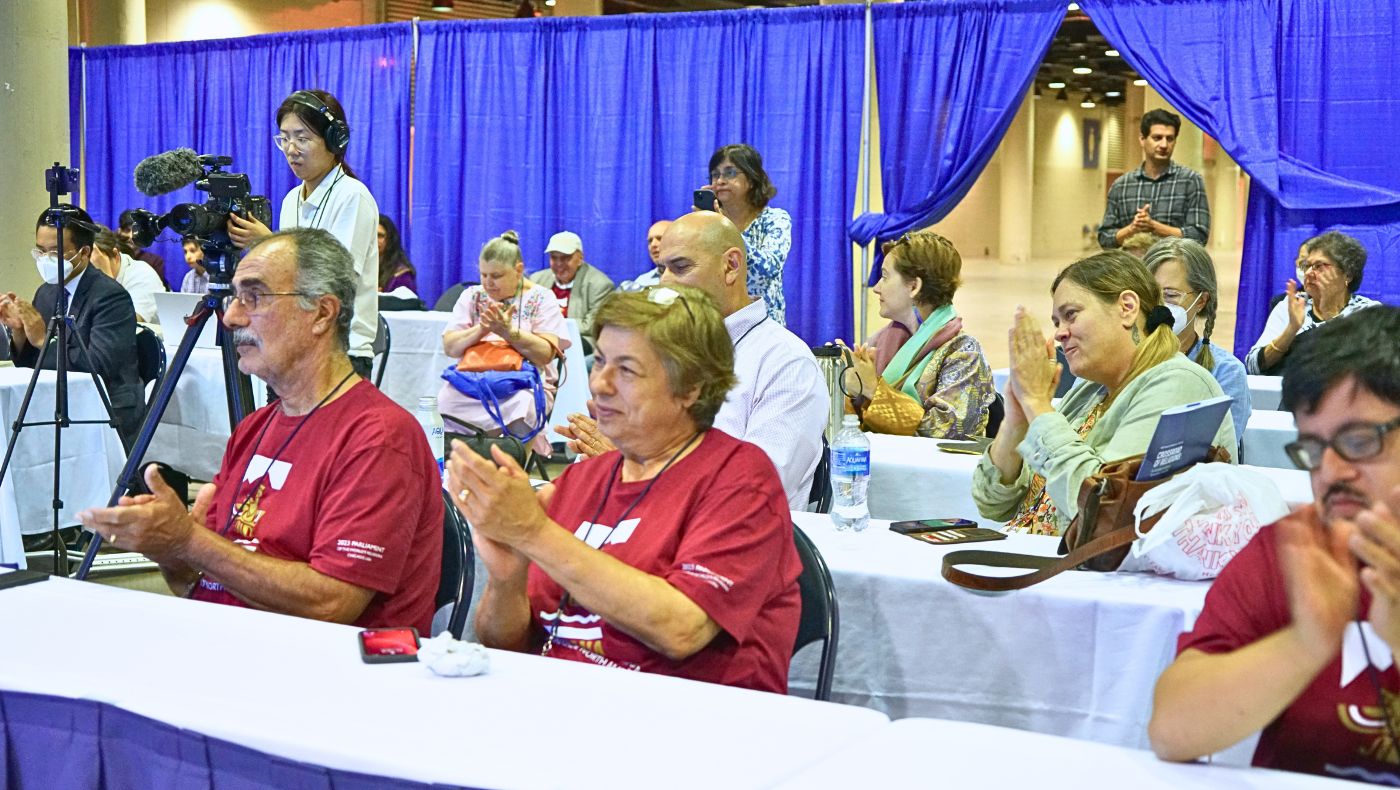
August 17, Day 4 of the 2023 Parliament of the World’s Religions, was rich in interfaith connection and reflection. Read our next blog about the Parliament’s concluding day.


